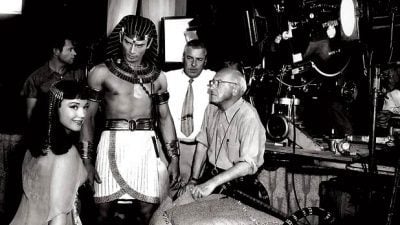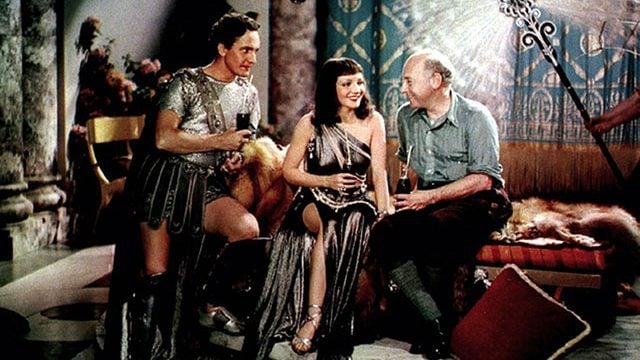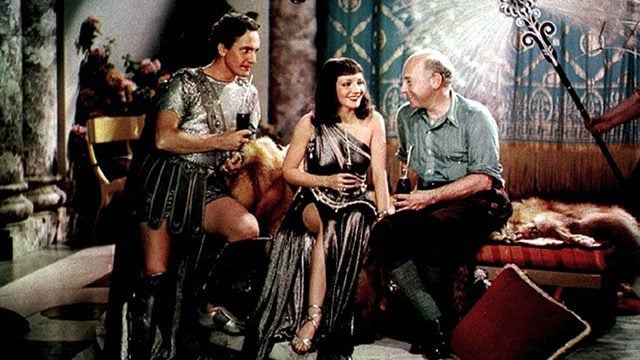The film industry has seen its fair share of career legends. For many of these big screen heroes, all they ever wanted to do was make movies. Amongst these legends there is one man who stands out among the rest. A producer-director who laid the foundation for the film industry we know and love today and is highly regarded as one of the founding fathers of cinema. Cecil B. DeMille is that cornerstone.

DeMille made his first major film at the age of 33 in the year of 1914. Over the next 44 years he would make 70 feature films, a mixture of both silent and sound films. When many film makers were attempting to make their mark in a specific genre, Cecil B. DeMille left his imprint on many genres including, Dramas, Comedies, Westerns, and Historical films.
DeMille literally started his career making history. His first film The Squaw Man, released in 1914, was the first full-length feature film shot in Hollywood. The Squaw Man is a silent Western that DeMille later revisited two more times. It is the only movie to ever have been successfully filmed three times by the same director.
With a success on his hands, DeMille kept moving forward and eventually founded the company Paramount Pictures. In the same year as the release of The Squaw Man, DeMille and his wife Constance Adams adopted a son. Many believe that the adoption was due to the fact that Adams previously had a miscarriage. With a successful company and new family at home, Cecil B. DeMille had things going his way.
His second film was The Virginian, which became his first film to be available in color-tinted format, although this version did not come out until a few years after the original was released. Over the next year DeMille and his peers literally created the building blocks of how film would be written and produced. By the year 1915, DeMille had directed 20 films. In just one year, he went from being a new film maker, to the quintessential leader of the film industry. This was also the year that one of DeMilles extras were killed on set. DeMille asked a man to unload all guns for rehearsal, however this was not done and an extra was killed. DeMille forced the one responsible out of town and never revealed his identity. In order to do the right thing, DeMille decided to keep the murdered extras wife on the payroll.

Working for years on literally building the film industry was exhausting work. DeMille decided he was in need of some rest, so he purchased a ranch in the Angeles National Forest and named the land “Paradise.” The main rule of the land was that no one was allowed to shoot or kill any animals on the property. He wanted to create a sanctuary, a place where he could truly relax and rest up.
In the year 1922 Cecil would have his first taste of a film even coming close to approaching failure. Due to not being able to run at full capacity after contracting rheumatic fever in Paris, DeMilles film Manslaughter was shockingly met with mixed emotions. Even the greats have moments of setbacks. When many men would see this as a failure, DeMille simply seen it as a learning experience and continued to do his best to produced innovated films that would redefine the industry.
The next year, 1923, DeMille released the film The Ten Commandments. The film had a budget of $600,000 which was the highest budget he had worked on so far. It is apparent that due to the issues with his previous film, DeMille was worried about the reception of this religious film, especially since it was so different from the films he previously produced. However, when it came out it became Paramount’s highest-grossing film. It held that record for 25 years until DeMille himself broke the record.
It was around this same time that Paramount came under heat and scandal. It is said that many who worked for the company were involved in horrible acts of rape and murder. Due to this accusation, a spotlight was placed on DeMille and his films. After some talk, a censorship board was put in place to keep things on the moral up and up. With these accusations and tension building, Cecil B. DeMille decided it was time to leave Paramount.

Now out on his own and trying to prove he could do things his own way, DeMille made a handful of films. Unfortunately, due to this new way of making his films, only one was successful. By 1928, silent films were no longer the way of film making and DeMille had to make the transition to “talkies.” Ever the innovator, DeMille designed a few different techniques to get the best video and sound from his films. These creations included a boom mic and camera crane.
Very few of his films at this time were met with high praise and after some years he decided to make the return to Paramount. Once back with the company he started with, DeMille put together the film The Sign of the Cross and was back on top as a successful film maker. The film was called a “masterpiece”, mostly due to DeMille compiling all of his abilities he learned over the last few years.
The accomplishments that Cecil B. DeMille obtained over his lifetime is a true American dream story. A man who had vision and drive who changes the way an industry is made. When he died in 1959, he left behind a tremendous legacy that any businessperson worth their weight in salt would drool at. Not only was he a founding father in the film industry, but over the years he was a political powerhouse, The Vice President of Bank of America, and owner of one of Americas first commercial airlines, Mercury Aviation Company.
Watch “The Ten Commandments” on TheLastPicture.Show
Written exclusively for TheLastPicture.Show by Jacob Ruble
Disclosure: The links on this page are “Affiliate Links” and while these are shown at no costs to our viewers, they generate commissions for our website(s)

